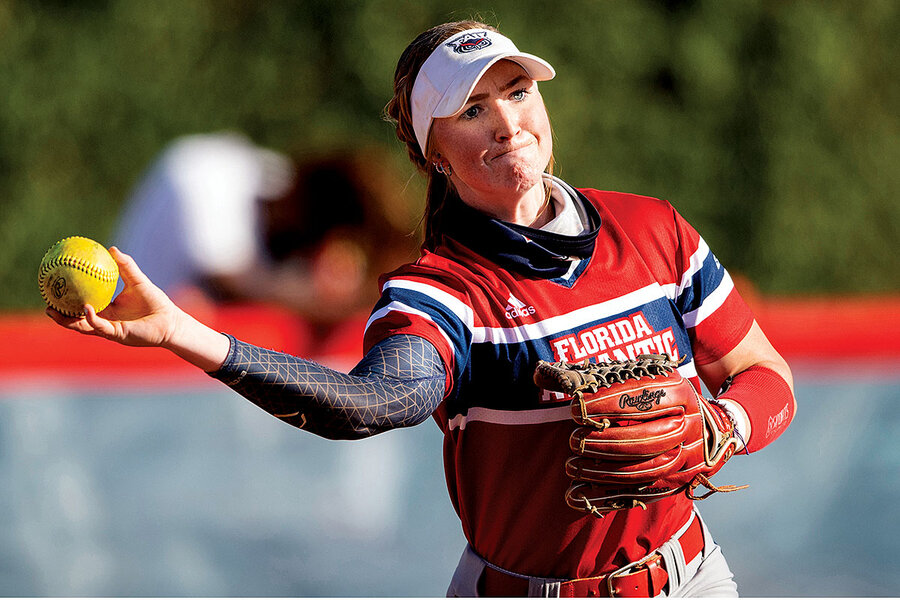How ‘name, image, likeness’ rights change the game for NCAA athletes
Loading...
College sports have long captured the hearts of fans around the nation who wear team colors to cheer on their favorite amateur athletes. And for a long time, colleges and universities have profited from their athletes’ stardom.
But this fall – for the first time – athletes can reap the financial rewards of their success, too.
The National Collegiate Athletic Association (NCAA) interim policy, as of July 1, lets more than 480,000 athletes monetize their name, image, and likeness (NIL), marking a dramatic shift for college sports. Through brand partnerships, athletes can now turn their successes on the field into cash in their pockets.
Why We Wrote This
The NCAA’s new policy permitting college athletes to profit on their name, image, and likeness rights is a sea change in college sports – and should empower student-athletes.
Why now?
Whether college athletes should be compensated for their NIL rights has been debated for years. In 2009, a UCLA basketball player sued the association after his likeness was used in a video game without his permission and without payment.
Over the next decade, athletes started advocating for their publicity rights directly to state and local legislators, says Braly Keller, NIL specialist at Opendorse. “Through those voices ... it started to snowball,” he says.
In 2019, California passed the Fair Pay to Play Act which allowed athletes to earn compensation for their NIL starting in 2023. Florida moved up the timeline, passing a similar bill that went into effect July 1, 2021.
To avoid giving individual states an unfair recruitment advantage, the NCAA drafted a new policy, but before it was put to a vote, the Department of Justice flagged it for containing a potential antitrust violation. Not wanting to subject itself to further litigation after the Supreme Court ruled this summer that the NCAA violated antitrust laws by limiting non-cash, educational benefits for athletes, the NCAA implemented a bare bones interim policy with two main stipulations: athletes cannot be paid for on-field performance and schools cannot offer impermissible incentives to attend.
“We’ve seen the NCAA really turn over the keys right to the schools … giving the schools a lot more power,” says Mr. Keller.
Who benefits?
It’s not just Olympians or Heisman Trophy winners who can cash in on the rule change. Athletes across the three divisions could see new opportunities – though deals will vary based on sport, institution, and even position.
Many schools are providing brand-building education so athletes can learn how to market themselves.
“Community connection is what creates the deal,” says Kamron Cox, NIL program coordinator at the University of Illinois. Mr. Cox anticipates that most athletes will profit through endorsement deals with local businesses – partnering with a sandwich shop or pizza joint hoping to draw hungry students.
But that also means the rule change could favor athletes who already benefit from established networks and media focus.
“All of the inequities, all of the power bases that are already there within the current sports world infrastructure are still going to be there,” explains Mary Jo Kane, professor emerita at University of Minnesota and founder of the Tucker Center for Research on Girls & Women in Sport.
Social media, however, could open new avenues, especially for savvy brand builders.
“[Social media] is removing the gatekeeper position of mainstream media and it puts the power and control on the athletes,” says Thilo Kunkel, associate professor of sport business at Temple University and director of the Sport Industry Research Center.
What concerns does it introduce?
With the contours of policy left to states and schools, rules vary around university logos, prohibited categories of deals, and steps for disclosure.
Dr. Kunkel worries some students might get lost in the complexity. “The education does matter, particularly for those athletes who are not the superstars,” he says. While athletes profiting significantly will be able to hire agents and marketing advisers, others will be juggling the roles of student, athlete, and businessperson.
On top of time management, Mr. Cox says the main challenge is making sure that students are creating healthy brands, but overall he feels a greater investment from community networks will help athletes set sail.
“Before there was a sense that a number of student athletes had some real value that was not maximized,” he says. “I think [athletes] can develop things now that can continue to be an asset … for the rest of [their] career.”






